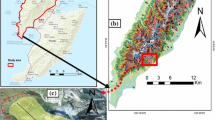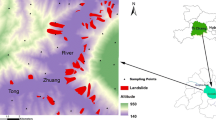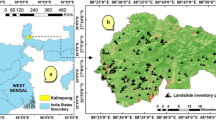Abstract
In the Three Gorges of China, there are frequent landslides, and the potential risk of landslides is tremendous. An efficient and accurate method of generating landslide susceptibility maps is very important to mitigate the loss of lives and properties caused by these landslides. This paper presents landslide susceptibility map** on the Zigui-Badong of the Three Gorges, using rough sets and back-propagation neural networks (BPNNs). Landslide locations were obtained from a landslide inventory map, supported by field surveys. Twenty-two landslide-related factors were extracted from the 1:10,000-scale topographic maps, 1:50,000-scale geological maps, Landsat ETM + satellite images with a spatial resolution of 28.5 m, and HJ-A satellite images with a spatial resolution of 30 m. Twelve key environmental factors were selected as independent variables using the rough set and correlation coefficient analysis, including elevation, slope, profile curvature, catchment aspect, catchment height, distance from drainage, engineering rock group, distance from faults, slope structure, land cover, topographic wetness index, and normalized difference vegetation index. The initial, three-layered, and four-layered BPNN were trained and then used to map landslide susceptibility, respectively. To evaluate the models, the susceptibility maps were validated by comparing with the existing landslide locations according to the area under the curve. The four-layered BPNN outperforms the other two models with the best accuracy of 91.53 %. Approximately 91.37 % of landslides were classified as high and very high landslide-prone areas. The validation results show sufficient agreement between the obtained susceptibility maps and the existing landslide locations.









Similar content being viewed by others
References
Akgun A, Sezer EA, Nefeslioglu HA, Gokceoglu C, Pradhan B (2012) An easy-to-use MATLAB program (MamLand) for the assessment of landslide susceptibility using a Mamdani fuzzy algorithm. Comput Geosci 38(1):23–34
Bai SB, Wang J, Lü GN, Zhou PG, Hou SS, Xu SN (2010) GIS-based logistic regression for landslide susceptibility map** of the Zhongxian segment in the three Gorges area, China. Geomorphology 115:23–31
Ballabio C, Sterlacchini S (2012) Support vector machines for landslide susceptibility map**: the Staffora river basin case study, Italy. Math Geosci 44:47–70
Bui DT, Lofman O, Revhaug I, Dick O (2011a) Landslide susceptibility analysis in the Hoa Binh province of Vietnam using statistical index and logistic regression. Nat Hazards 59:1413–1444
Bui DT, Pradhan B, Lofman O, Revhaug I, Dick OB (2011b) Landslide susceptibility map** at Hoa Binh province (Vietnam) using an adaptive neuro-fuzzy inference system and GIS. Comput Geosci 45:199–211
Bui DT, Pradhan B, Lofman O, Revhaug I (2012a) Landslide susceptibility assessment in Vietnam using support vector machines, decision tree and Naïve Bayes models. Math Probl Eng. doi:10.1155/2012/974638
Bui DT, Pradhan B, Lofman O, Revhaug I, Dick OB (2012b) Landslide susceptibility assessment in the Hoa Binh province of Vietnam: a comparison of the Levenberg-Marquardt and Bayesian regularized neural networks. Geomorphology 171–172:12–29
Bui DT, Pradhan B, Lofman O, Revhaug I, Dick OB (2012c) Spatial prediction of landslide hazards in Hoa Binh province (Vietnam): a comparative assessment of the efficacy of evidential belief functions and fuzzy logic models. Catena 96:28–40
Cabalar AF, Cevik A, Gokceoglu C (2012) Some applications of adaptive neuro-fuzzy inference system (ANFIS) in geotechnical engineering. Comput Geotech 40:14–33
Carro M, De Amicis M, Luzi L, Marzorati S (2003) The application of predictive modeling techniques to landslides induced by earthquakes, the case study of the 26 September 1997 Umbria–Marche earthquake (Italy). Eng Geol 69:139–159
Choi J, Oh HJ, Won JS, Lee S (2010) Validation of an artificial neural network model for landslide susceptibility map**. Environ Earth Sci 60:473–483
Dai FC, Lee CF (2002) Landslide characteristics and slope instability modeling using GIS, Lantau Island, Hong Kong. Geomorphology 42(3–4):213–228
Ercanoglu M, Gokceoglu C (2002) Assessment of landslide susceptibility for a landslide-prone area (north of Yenice, NW Turkey) by fuzzy approach. Environ Geol 41(6):720–730
Falaschi F, Giacomelli F, Federici PR, D’Amato Avanzi G, Pochini A, Ribolini A (2009) Logistic regression versus artificial neural networks: landslide susceptibility evaluation in a sample area of the Serchio River valley, Italy. Nat Hazards 50:551–569
Fourniadis IG, Liu JG, Mason P (2007) Landslide hazard assessment in the Three Gorges area, China, using ASTER imagery: Wushan-Badong. Geomorphology 84:126–144
Gokceoglu C, Sonmez H, Ercanoglu M (2000) Discontinuity controlled probabilistic slope failure risk maps of the Altindag (settlement) region in Turkey. Eng Geol 55:277–296
Gorsevski PV, Piotr J (2008) Discerning landslide susceptibility using rough sets. Comput Environ Urban 32:53–65
Guzzetti F, Carrarra A, Cardinali M, Reichenbach P (1999) Landslide hazard evaluation: a review of current techniques and their application in a multi-scale study, Central Italy. Geomorphology 31:181–216
He SW, Pan P, Dai L, Wang HJ, Liu JP (2012) Application of kernel-based Fisher discriminant analysis to map landslide susceptibility in the Qinggan River delta, Three Gorges, China. Geomorphology 171–172:30–41
Hubei Province Geological Survey (1965) Geological map of Zigui-Wushan (1:200,000)
Kanungo DP, Arora MK, Sarkar S, Gupta RP (2006) A comparative study of conventional, ANN black box, fuzzy and combined neural and fuzzy weighting procedures for landslide susceptibility zonation in Darjeeling Himalayas. Eng Geol 85(3–4):347–366
Komac M (2006) A landslide susceptibility model using the analytical hierarchy process method and multivariate statistics in penialpine Slovenia. Geomorphology 74(1–4):17–28
Lee S (2005) Application of logistic regression model and its validation for landslide susceptibility map** using GIS and remote sensing data. Int J Remote Sens 26:1477–1491
Lee S (2007) Comparison of landslide susceptibility maps generated through multiple logistic regression for three test areas in Korea. Earth Surf Proc Land 32:2133–2148
Liu JP, Zeng ZP, Liu HQ, Wang HB (2011) A rough set approach to analyze factors affecting landslide incidence. Comput Geosci 37:1311–1317
Oh JJ, Pradhan B (2011) Application of a neuro-fuzzy model to landslide susceptibility map** in a tropical hilly area. Comput Geosci 37(9):1264–1276
Ohlmacher GC, Davis JC (2003) Using multiple logistic regression and GIS technology to predict landslide hazard in northeast Kansa, USA. Eng Geol 69:331–343
Pawlak Z (1982) Rough sets. Int J Comput Inf Sci 11(5):341–356
Pawlak Z (1991) Rough sets: theoretical aspects of reasoning about data. Kluwer Academic Publishers, Dordrecht
Pawlak Z (1997) Rough set approach to knowledge-based decision support. Eur J Oper Res 99(1):48–57
Pawlak Z, Slowinski R (1994) Rough set approach to multi-attribute decision analysis. Eur J Oper Res 72:443–459
Pradhan B (2010a) Application of an advanced fuzzy logic model for landslide susceptibility analysis. Int J Comput Int Sys 3(3):370–381
Pradhan B (2010b) Landslide susceptibility map** of a catchment area using frequency ratio, fuzzy logic and multivariate logistic regression approaches. J Indian Soc Remote Sens 38(2):301–320
Pradhan B (2010c) Remote sensing and GIS-based landslide hazard analysis and cross-validation using multivariate logistic regression model on three test areas in Malaysia. Adv Space Res 45(10):1244–1256
Pradhan B (2011a) Manifestation of an advanced fuzzy logic model coupled with geoinformation techniques to landslide susceptibility map** and their comparison with logistic regression modelling. Environ Ecol Stat 18(3):471–493
Pradhan B (2011b) Use of GIS-based fuzzy logic relations and its cross application to produce landslide susceptibility maps in three test areas in Malaysia. Environ Earth Sci 63(2):329–349
Pradhan B (2012) A comparative study on the predictive ability of the decision tree, support vector machine and neuro-fuzzy models in landslide susceptibility map** using GIS. Comput Geosci. http://dx.doi.org/10.1016/j.cageo
Pradhan B, Buchroithner MF (2010) Comparison and validation of landslide susceptibility maps using an artificial neural network model for three test areas in Malaysia. Environ Eng Geosci 16(2):107–126
Pradhan B, Lee S (2010) Regional landslide susceptibility analysis using back-propagation neural network model at Cameron Highland, Malaysia. Landslides 7:12–30
Pradhan B, Pirasteh P (2010) Comparison between prediction capabilities of neural network and fuzzy logic techniques for landslide susceptibility map**. Disa Adv 3(2):26–34
Pradhan B, Lee S, Mansor S, Buchroithner M, Jamaluddin N, Khujaimah Z (2008) Utilization of optical remote sensing data and geographic information system tools for regional landslide hazard analysis by using binomial logistic regression model. J Appl Remote Sens 2:1–11
Sezer EA, Pradhan B, Gokceoglu C (2011) Manifestation of an adaptive neuro-fuzzy model on landslide susceptibility map**: Klang valley, Malaysia. Expert Syst Appl 38(7):8208–8219
Shou KJ, Wang CF (2003) Analysis of the Chiufengershan landslide triggered by the 1999 Chi–Chi earthquake in Taiwan. Eng Geol 68:237–250
Süzen ML, Doyuran V (2004a) A comparison of the GIS based landslide susceptibility assessment methods: multivariate versus bivariate. Environ Geol 45(5):665–679
Süzen ML, Doyuran V (2004b) Data driven bivariate landslide susceptibility assessment using geographical information systems: a method and application to Asarsuyu catchment, Turkey. Eng Geol 71(3–4):303–321
Wu SR, Shi L, Wang RJ, Tan CX, Hu DG, Mei YT, Xu RC (2001) Zonation of the landslide hazards in the forereservoir region of the Three Gorges Project on the Yangtze River. Eng Geol 59:51–58
Yalcin A, Reis S, Aydinoglu AC, Yomralioglu T (2011) A GIS-based comparative study of frequency ratio, analytical hierarchy process, bivariate statistics and logistics regression methods for landslide susceptibility map** in Trabzon, NE Turkey. Catena 85(3):274–287
Yao X, Tham LG, Dai FC (2008) Landslide susceptibility map** based on support vector machine: a case study on natural slopes of Hong Kong, China. Geomorphology 101:572–582
Yeon YK, Han JG, Ryu KH (2010) Landslide susceptibility map** in Injae, Korea, using a decision tree. Eng Geol 116(3–4):274–283
Yesilnacar E, Topal T (2005) Landslide susceptibility map**: a comparison of logistic regression and neural networks methods in a medium scale study, Hendek region (Turkey). Eng Geol 79(3–4):251–266
Yilmaz I (2009) A case study from Koyulhisar (Sivas-Turkey) for landslide susceptibility map** by artificial neural networks. Bull Eng Geol Environ 68:297–306
Yilmaz I (2010) Comparison of landslide susceptibility map** methodologies for Koyulhisar, Turkey: conditional probability, logistic regression, artificial neural networks, and support vector machine. Environ Earth Sci 61:821–836
Zarea M, Pourghasemi HR, Vafakhah M, Pradhan B (2012) Landslide susceptibility map** at Vaz watershed (Iran) using an artificial neural network model: a comparison between multi-layer perceptron (MLP) and radial basic function (RBF) algorithms. Arab J Geosci. doi:10.1007/s12517-012-0610-x
Acknowledgments
The authors would like to thank Prof. Pradhan and Dr. LaMoreaux for the helpful comments which improved the manuscript greatly. The study is jointly supported by NSFC (41271455/D0108), Open Research Fund of Key Laboratory of Disaster Reduction and Emergency Response Engineering of the Ministry of Civil Affairs (LDRERE20120207), the Fundamental Research Funds for the Central Universities, China University of Geosciences (Wuhan) (CUGL120207), and Open Research Fund Program of Key Laboratory of Digital Map** and Land Information Application Engineering, National Administration of Surveying, Map** and Geoinformation (GCWD201101).
Author information
Authors and Affiliations
Corresponding author
Rights and permissions
About this article
Cite this article
Wu, X., Niu, R., Ren, F. et al. Landslide susceptibility map** using rough sets and back-propagation neural networks in the Three Gorges, China. Environ Earth Sci 70, 1307–1318 (2013). https://doi.org/10.1007/s12665-013-2217-2
Received:
Accepted:
Published:
Issue Date:
DOI: https://doi.org/10.1007/s12665-013-2217-2




